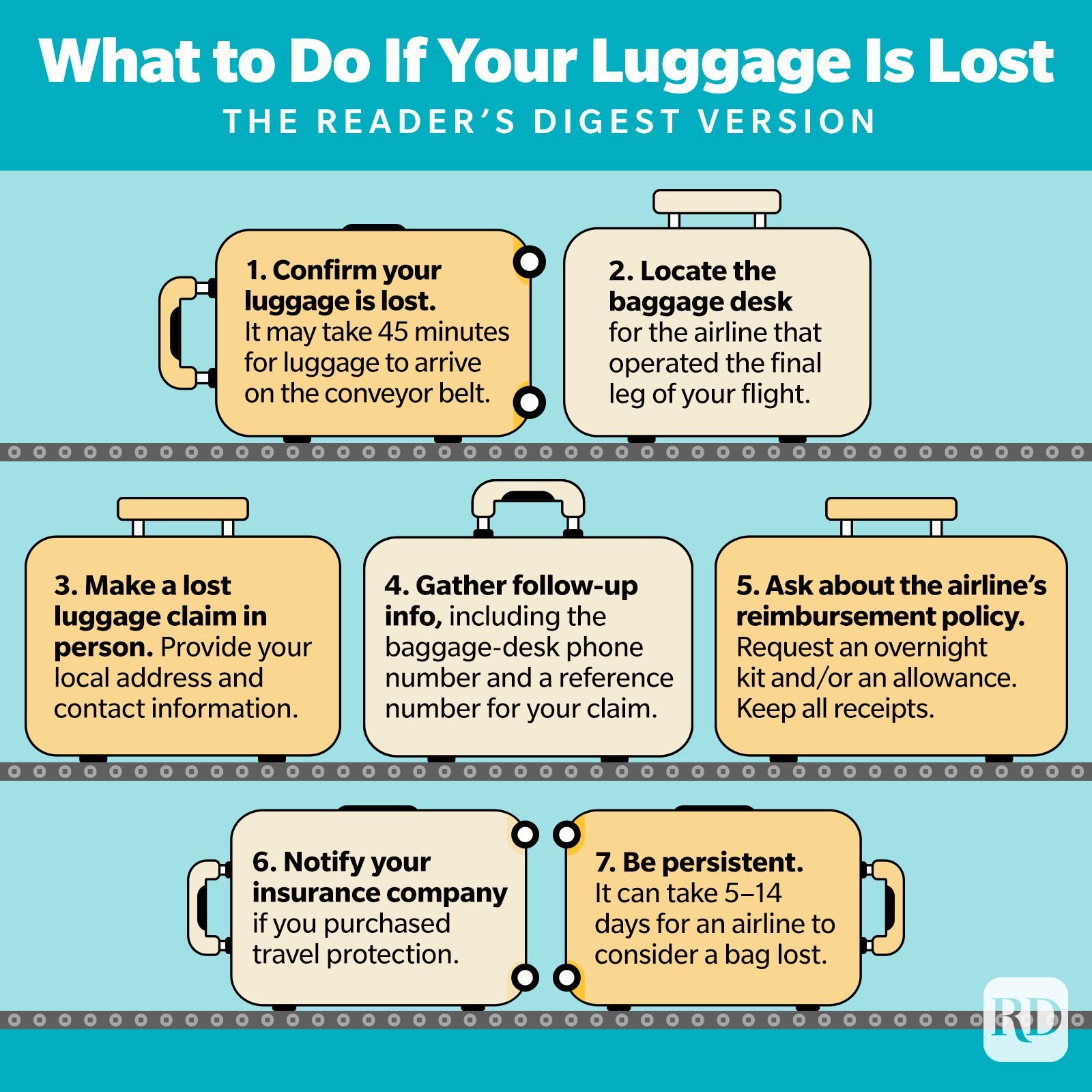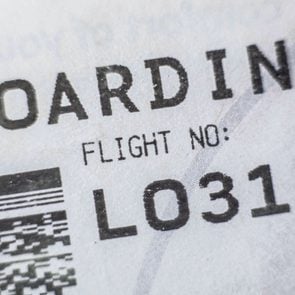What to Do If an Airline Loses Your Luggage: 7 Simple Steps
Updated: Mar. 20, 2024

Lost luggage (unfortunately) happens. Here's what to do if an airline loses your precious cargo.
It’s a terrible feeling to watch the last person on your flight retrieve their checked bags from the baggage carousel, knowing yours isn’t coming around the bend. If you’ve ever had to deal with lost luggage, you’re hardly alone.
In 2022, U.S. airlines lost, delayed or damaged more than 2.9 million checked bags, equaling a mishandled baggage rate of 0.64% (higher than 0.51% in 2021). Globally, SITA (a leading aviation IT provider) reported that an astonishing 26 million bags were misplaced in 2022. And the past few months have shown no improvement, either. In fact, in the first quarter of 2023, the U.S. Department of Transportation reported that U.S. airlines lost or mishandled more than 721,000 bags checked on domestic flights—about the same rate we saw in 2022.
Although a delayed or canceled flight can be the difference between bags that make it to your final destination and those that wind up on the lost luggage list, there are things you can do to prevent the airline from losing your luggage—and things you can do to smooth the process if it does happen. As you plan your trip and head to the airport, consider whether it’s smart to check your bag. And follow these DOT-approved tips if your bags happen to be misplaced.
Get Reader’s Digest’s Read Up newsletter for more travel, humor, cleaning, tech and fun facts all week long.
What to do if your bag is lost
If your suitcase doesn’t show up at baggage claim, there are steps you can take to increase your chances of recovering it. You can also receive compensation for the lost luggage if it isn’t found in a timely matter—or at all. Here’s what you need to do.
Step 1: Wait to confirm your luggage is lost
You’ll need to confirm that your luggage is actually lost, delayed or misplaced first. Airline workers may offload a flight’s bags in waves, so wait at least 45 minutes for luggage to arrive on the conveyor belt. After 45 minutes, check nearby conveyor belts, says Valerie Edman, owner and luxury travel advisor at Cultured Travel. Check to see if you can track your bag using the airline’s app, if it has one, or on its website. If you have an Apple AirTag, make sure you’re tracking it. Still no luggage? Remain calm.
Step 2: Talk to a desk agent
Locate the baggage desk for the airline that operated the final leg of your flight. No matter how hurried you are to get where you’re going, avoid the temptation to handle your lost luggage over email.
“Even if you’re ready to leave the airport and get to your final destination, go to the airline’s customer care desk inside the luggage arrival hall [first],” says Frank Harrison, a World Travel Protection regional security director. “If there is no customer support desk or personnel in the baggage claim area, go to the main customer service desk on the check-in side of the terminal.”
Step 3: File a claim
“You must make a lost luggage claim at the airport, in person, unless the airline staff directs you to call a service number, preferably on a phone they provide,” Harrison says. While filing a missing baggage report with the desk agent, provide as much information as possible, including a local address for you or your party and contact information so the airline can get in touch or deliver the luggage to you once it’s found.
Step 4: Gather necessary information
The last thing you want (after lost luggage, of course) is to leave the airport and realize you have more questions for the baggage claim agent. Edman stresses how important it is to retrieve the necessary information for any follow-ups. This includes the direct phone number of the baggage desk, a reference or tracking number for your claim and any additional direct lines, emails or contacts to make it easy for you to check in.
Step 5: Ask about reimbursement
What will the airline cover for reimbursement? Confirm their reimbursement policy now. You can also request an overnight kit and ask for an allowance for reasonable expenses. If you go shopping to get the basics, make sure to keep all the receipts. Even if you aren’t provided an allowance by the airline, keep all necessary purchase receipts for your records.
Step 6: Call your travel insurance company
If you purchased a travel insurance plan, you’ll want to notify the company at this point. It should cover lost or delayed luggage, so call to find out the specifics of your coverage and how to file a claim.
Step 7: Be persistent
According to the DOT, airlines don’t consider missing bags lost right away. Although policies differ by company and may depend on whether you were traveling domestically or internationally, it usually takes between 5 and 14 days post-flight for an airline to declare a bag is lost. In that timeframe, make sure you’re persistent calling customer service and following up.

Questions to ask the airlines about your lost luggage
Whether you’re speaking to a desk agent or customer service representative, make sure you gather all the necessary information as soon as possible. There are a host of things airlines won’t tell you, so it’s best to read the fine print, ask questions and get your answers in writing. Here are some questions experts suggest asking while you’re speaking with airline employees.
- Will my missing baggage be delivered free of charge? Some sources say that airlines are required to deliver your bags free of charge, but as the DOT website states, “Don’t assume that the airline will deliver the bag without charge when it is found; ask the airline about this.”
- Will you reimburse me for things I need to buy for myself before my baggage gets returned? Find out whether the airline will cover reasonable expenses. If not, you need to know the details of its reimbursement policy before you hit up a local Target for the basics. According to the DOT, airlines that don’t provide cash advances for necessities may reimburse you for purchases of those items—a traveler needs clean underwear, after all.
- Can you provide me with a list of all the items eligible for reimbursement? Instead of assuming, the department suggests discussing exactly which items an airline will reimburse you for buying and keeping your receipts. Athletic travelers will be pleased to hear that airlines that misplace sporting equipment may cover your fee for the rental of replacements.
What airlines do and don’t cover
When it comes to lost luggage reimbursement, it’s unfortunately not a realistic expectation for the airline to cover every last item in the suitcase. Per the DOT’s regulations, airlines don’t have to pay more than $3,800 for luggage lost on domestic flights. And the maximum amount they’re liable for on luggage lost during international flights is $1,780.
“In this day and age of travel, few airlines will offer more than a lost report opportunity and an eventual small settlement if permanently lost,” says Harrison. “Before you travel, verify if the airline offers support beyond tracking and loss claims. Make sure you know the replacement value coverage. Some policies will only cover a portion of the claimed loss, so know in advance before you pack that expensive branded bag and clothes.”
As for what the airline owes you when your bags are missing or have been delayed, there are DOT regulations in place for that. For starters, airlines are responsible for locating the bag, and they need to reimburse travelers for reasonable expenses incurred while they waited for their bags. While they’re prohibited from setting a random reimbursement amount for daily expenses, they’re able to set a maximum fee for reimbursements.
It’s best to check your airline’s lost luggage policy before you fly, but here are some examples:
- Spirit Airlines: Covers “reasonably priced purchases” of essential items such as toiletries and clothing. They will not reimburse cosmetics, which are among a long list of other items they deem non-essential.
- Delta Airlines: Reimburses “reasonable expenses” up to $50 per day for the first five days.
- United Airlines: Allows for “reimbursement of expenses,” but only with proper proof of payment and claim form.
What to do if your baggage is delayed
You’ll want to take many of the early steps recommended with lost luggage. As mentioned above, it’s important that you do not leave the airport without filing a missing baggage report, so your bag can be returned to you as quickly as possible, whether it’s on another flight or delayed from a connecting flight. Make sure to keep your original bag tag so you can track your luggage online, as this will most certainly be faster than waiting for your airline to contact you directly. If you haven’t received any updates in 24 hours, it doesn’t hurt to try escalating your claim via social media or by calling customer service for immediate assistance. Staying proactive and persistent is key to your claim not being forgotten.
How travel insurance can help with lost luggage
Travel insurance helps with lost luggage as well as travel mishaps, such as last-minute flight cancelations and delays or rental car issues. It’s a safety net in case you end up sans luggage, and it’s one that’s probably worth the investment, experts say. If your bags get delayed, the insurance may cover the cost of essential items to tide you over. And if they unexpectedly go missing, your travel insurance will compensate you for the loss.
Susan Sherren, founder of luxury travel consulting agency Couture Trips, prefers Allianz travel insurance for her trips, but her bottom line is this: When faced with lost luggage, you’ll have an easier time dealing with your travel insurance than with the airline.
If you don’t want to buy travel insurance, you can sign up for a service such as Blue Ribbon Bags, which helps expedite and locate any lost luggage. Rates start at $5 per bag, and if the company doesn’t find your lost luggage within 96 hours, it pays out $1,000 per bag.
How your credit card could help with lost luggage
You might not need separate travel insurance if you have a credit card that offers travel coverage. Anthony Martin, founder and CEO of Choice Mutual, is not only an insurance agent but also a frequent business traveler. He points out that many credit cards offer protection from loss or damage on a wide range of things, including delayed or lost luggage.
“Chase will reimburse up to $3,000 for damaged luggage on a flight that was booked using your Chase Sapphire Reserve card,” Martin says. The card also gives travelers with lost luggage $100 a day for up to five days so they can purchase essentials, such as toiletries, clothes and one cell phone charger.
It’s worth noting that the Chase Sapphire Reserve has an annual fee of $550 a year. Still, it may be worth it for frequent fliers.
How to prevent lost luggage
Looking for some smart things travelers do to prevent lost luggage? We’ve got the tips.
Pack a tracking device
Tech expert and frequent flier Andreas Grant of Networks Hardware recommends using an Apple AirTag. “I specifically suggest AirTags,” he says. “One of my friends managed to recover his bag using an AirTag even though the airline authority was claiming that they lost [the luggage]. My friend gave them the exact location of his missing bag, which helped him stand his ground and request the airlines do their job.”
Fly nonstop
Nonstop flights can be more expensive, but they’re also one of the best ways to prevent lost luggage. There’s no need to worry about your bag making it onto a connecting flight when there are airline delays or time is otherwise cut short. Fly direct when possible, as this limits the number of transfers your luggage has to do.
Use a carry-on
Packing mistakes can lead to overstuffed bags that need to be checked, and checked bags are at risk for being lost. The solution: Learn what to pack in a carry-on—you can’t lose a bag if you don’t check it, which is why traveling with only a carry-on is a fool-proof way to prevent lost luggage.
“Avoid checking bags for domestic flights—period,” Sherren says. “And pack two days worth of clothing and necessary toiletries in your carry-on if you travel overseas and check any luggage.”
Take inventory
Know everything you pack in your bags. While this won’t prevent lost luggage, proper documentation will help the reimbursement process—the more you can prove, the better off you’ll be. “Pre-departure, document and take photos of packed items and luggage conditions to aid a lost or damaged luggage claim,” Edman says.
And make sure it’s clear that these items made it to the airport with you. “Take a photo of your bag at the airport, displaying your ID tag, before checking in,” Sherren says.
If you buy new things right before a trip, save all the receipts and take photos of these items in your luggage. “You’ll need to prove the value of your lost belongings,” says Edman. “This can be done with receipts, but if you don’t have receipts, you may be able to provide an estimate of the value of your belongings.”
Additional reporting by Jaime Stathis.
About the experts
- Valerie Edman is the owner of Cultured Travel, a boutique travel consulting firm that specializes in luxury, meaningful travel, customized itineraries and seamless journeys.
- Frank Harrison is the regional security director of North America for World Travel Protection, where he delivers real-time security intelligence to keep travelers safe.
- Susan Sherren is the founder of luxury travel agency Couture Trips.
- Anthony Martin is the founder and CEO of Choice Mutual, and has been a licensed insurance agent since 2010. He specializes in helping seniors with life insurance.
- Andreas Grant is a frequent flier and tech expert at Networks Hardware, a company he founded to make it easier for people to pick the right Internet hardware for their homes.
Sources:
- U.S. Department of Transportation: “Air Travel Consumer Reports for 2022” & “Air Travel Consumer Reports for 2023”
- U.S. Department of Transportation: “Lost, Delayed, or Damaged Baggage”
- Radical Storage: “U.S. Airlines: Which Mishandle Baggage & Oversell Seats the Most”
- SITA: “Baggage IT Insights 2023”
- United: “Issues with your checked bags”
- Delta: “Delayed, lost or damaged baggage”
- Spirit: “What if my bag is delayed/lost?”





















